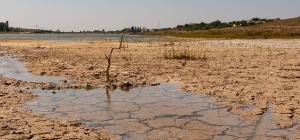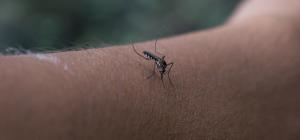
[ARCHIVED] Heat advice: Clothing
[This content has been archived. We archive content that is dated 10 years or older or content with rapidly evolving evidence or guidance that is now out of date (e.g., COVID-19). If you have feedback, please contact us at [email protected].]
“Dress appropriately in light-weight, light-coloured clothing.” (Environment Canada, Heat, 2002)
One of the most common forms of advice during hot weather is to wear light, loose-fitting clothing made of natural fibres. This seems logical; however, most technical clothing designed to increase thermal comfort and performance for athletes is close-fitting and made of synthetic wicking materials. This kind of athletic gear is presumably the result of extensive market and scientific research, yet is in opposition to common advice for dealing with heat.
The Research
Transfer of heat away from the body is affected by a variety of factors including air movement (i.e., wind), relative humidity, sunshine, and clothing. Clothing affects air circulation over the skin as well as evaporative cooling and moisture regulation. If moisture cannot evaporate from the skin, both skin temperature and discomfort increase.1 Adequate ventilation or air movement can reduce the insulation properties of clothing by 5 to 50%.2
Heat transfer through clothing is affected by:
- Fibre type. Natural fibres absorb more moisture than synthetic fibres and moisture absorption is associated with increased comfort.2 However, many synthetics have wicking properties which move moisture to the outside where it can more easily evaporate.3
- Yarn type. Natural fibres are shorter and therefore rougher than the long smooth filaments associated with synthetic fibres. Smooth fibres are less apt to trap heat, making them feel cooler.
- Fabric construction. Tightly woven fabrics with a high thread count are warmer because they are less permeable to air and thus prevent convective heat loss. Flexible fabrics allow more warm air to pass through, away from the body.2
- Fabric thickness. Thin fabric permits more evaporation.1
- Garment type. Fibre type is more important for tighter garments than loose garments. Fabric structure becomes more important for loose garments.1
- Finishes. Waterproofing and water repellent finishes prevent heat loss.2 Light colours reflect more radiant heat than bare skin, potentially offering some protection.1
Experimental Studies
In a study of six female subjects, Ha et al.3 found that local sweating, and thus thermal stress, was higher with hydrophobic polyester fabrics than hydrophilic cotton fabrics at 37°C and 60% relative humidity. Higher sweat rates did not result in more efficient cooling of the body. Among five women, Ha et al.4 also compared cotton to polyester during intermittent light exercise at 24°C and 50% relative humidity. They found that onset of sweating was earlier, self-reported thermal sensation was warmer, pulse rate was higher, and changes in rectal temperature were greater among subjects wearing polyester versus cotton clothing. Subjects also felt wetter in polyester, especially during the latter half of the 90-minute study period. It was concluded that cotton provided less thermal insulation due to its increased ability to absorb moisture, likely accelerating heat loss.
Zhang et al.5 compared seven women at rest in hot (up to 35°C) and cool (20°C) environments at 60% relative humidity wearing two types of cotton clothing (high and low air permeability) with Tencel® (a cellulose fibre with a higher moisture regain than cotton). Rectal temperature was highest for low permeable cotton throughout the experimental protocol. In the cool phase, permeable cotton and Tencel® resulted in similar rectal temperatures, suggesting that at cool temperatures air permeability is most important for body cooling. At warmer temperatures, women wearing Tencel® had significantly lower rectal temperatures than those wearing permeable cotton; the authors concluded that the higher moisture regain of Tencel® facilitated a wicking action that improved evaporative heat loss.
Laing et al.6 examined three types of technical outdoor garments—polyester interlock, plated wool/polyester blend, and merino wool single jersey—on ten athletically trained men in both hot and cold temperatures. Fewer differences were found between garments in hot versus cold trials, and no differences were noted when running in heat. Moreover, subjective sensations did not differ between garments. However, the measured loss of body mass from sweat was higher (not statistically significant) with polyester clothing. Sweating and increased skin temperature began sooner and heart rate was higher with polyester; as well, the sensation of wetness was higher during activity when wearing polyester interlock clothing. Skin temperatures were higher with polyester than with wool and heart rate was higher in polyester during walking. Although polyester fabric is technically less warm than wool or wool blends (according to simulated laboratory parameters), subjects felt hotter and less comfortable while wearing it.
An earlier study by Tokura and Natsume7 also compared wool and polyester knit clothing. In a hot environment (34°C, 63% relative humidity), they compared six females during 45 minutes of rest, followed by 10 minutes of exercise and another 45-minute rest period. When the subjects were at rest (i.e., not sweating), the surface temperature of wool clothing was higher than that of polyester, suggesting more efficient dry heat loss through wool. During exercise and recovery (i.e., sweating), the authors found that heat storage, sweat production, and rectal temperature were all higher among women wearing polyester clothing. Notably, the polyester fibre used had a wicking rate of 0 mm/10 min, suggesting that this was not a wicking fabric like that used in many technical performance garments.
Kwon et al.8 compared a highly absorbent wool/cotton blend, cotton with average moisture regain, and hydrophobic polyester during intermittent exercise at 30°C and 50% relative humidity. They measured greater sweat rates and higher chest skin temperature among women wearing polyester. The wool/cotton blend resulted in the lowest skin temperatures.
Summary
Overall, these experiments indicate that people wearing polyester fibres in hot environments tend to have higher body temperatures, sweat more, and experience greater discomfort than those wearing cotton or wool. However, the wicking properties are not always stated, and it is not clear whether the polyester fibres used in the studies differ from technical fibres marketed as wicking fabrics. Moreover, all studies, but one, were conducted on women, and all involved young university-aged subjects. None of the studies examined extremely high humidity environments, as compared with many extreme heat events. Thus, questions remain about which type of clothing is most protective during hot weather.
Gaps and Questions
- What is the optimal type of clothing to wear during periods of extreme heat for non-athletes?
- What is the role of wicking fabrics in improving evaporative cooling?
- Does thermal comfort of fabrics differ between normal activity and exercise?
- Are there differences in synthetics vs. technical fibres? What about natural technical fibres (e.g., technical merino wool or cellulose microfibres)?
- Are there sex differences in body heat regulation that are affected by clothing type?
- Do age effects on thermoregulation indicate different clothing requirements for children and older people?
References
- Pascoe DD, Bellingar TA, McClusky BS. Clothing and exercise. II. Influence of clothing during exercise/work in environmental extremes. Sports Med. 1994;18(2):94-108.
- Pascoe DD, Bellingar TA, McClusky BS. Clothing and exercise. I: Biophysics of heat transfer between the individual, clothing and environment. Sports Med. 1994;18(1):38-54.
- Ha M, Tokura H, Yamashita Y. Effects of two kinds of clothing made from hydrophobic and hydrophilic fabrics on local sweating rates at an ambient temperature of 37°C. Ergonomics. 1995;38(7):1445-55.
- Ha M, Tokura H, Yamashita Y. Effects of moisture absorption by clothing on thermal responses during intermittent exercise at 24°C. Eur J Appl Physiol Occup Physiol. 1995;71(2): 266-71.
- Zhang P, Gong RH, Yanai Y, Tokura H. Influence of clothing material properties on rectal temperature in different environments. Int J Clothing Sci Tech. 2002;14(5):299-306.
- Laing RM, Sims ST, Wilson CA, Niven BE, Cruthers NM. Differences in wearer response to garments for outdoor activity. Ergonomics. 2007;51:492-510.
- Tokura H, Natsume K. The effects of different clothing on human thermoregulation at an ambient temperature of 34 C. Trans Menzies Foundation. 1987;14:279–81.
- Kwon A, Kato M, Kawamura H, Yanai Y, Tokura H. Physiological significance of hydrophilic and hydrophobic textile materials during intermittent exercise in humans under the influence of warm ambient temperature with and without wind. Eur J Appl Physiol Occup Physiol. 1998;78(6):487-93.








